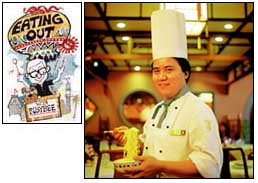


 Chef Penpa Tsering's Sampan is as authentic a Chinese restaurant as you may find in Hong Kong or Beijing. But Chef Penpa is a Tibetan from Lhasa, he came to India, over the mountains and through the snow passes of the Himalayas, in the footsteps of the Dalai Lama. |
|
Show boat to China
The frontline restaurant of Holiday Inn on Bombay's Juhu Beach is Chinese. And, under the care of Chef Penpa Tsering, it is as authentic a Chinese as any you may find in Hong Kong or Beijing. Chef Tsering is a Tibetan from Lhasa, and he came to India, over the mountains and through the snow passes of the Himalayas, in the footsteps (at that time not Gucci-enclosed) of the Dalai Lama.
Well, not exactly, he was carried across by his parents, he was too young to walk. The Tserings settled in Kalimpong, where Penpa went to school and learnt cooking. The cooking he learnt from an uncle, with whom he first worked at the Claridges in New Delhi and then at the Holiday Inn when it opened in Bombay.
The Khannas of Holiday Inn are particular about their food - bless them. They were among the first to get Chinese chefs from Singapore and Hong Kong and to import restaurant ingredients and implements - rice wine from Hong Kong, salted black beans and sesame oil from Singapore, crockery from Thailand. Penpa learnt under his peers and was himself sent to the Orient to cook in its restaurants and work in its kitchens.
He still makes an annual trip to keep in touch. His repertoire is mainly Szechwan, though there are a few milder Cantonese dishes on the menu, and some Korean barbecue. He also prepares a special menu for his favourite clients, if they tell him on the morning of their visit, the menu printed and ready on the table.
To the Sampan, then. I prefer the afternoons, they are more indolent and designed for Chinese banquets and lesser meals. The large picture windows bring in the Juhu sun and the Arabian Sea, and on the sun-deck, next to the swimming-pool, there are white skins, probably an airline crew, getting gently pink broiled. It is a lobby-level restaurant and there is only one entrance, through the coffee shop (Sidewalk Cafe). It is an idea I appreciate.
The coffee shop is bright in gold and green, the green of actual plants. You walk the length of it, taking in the rick coffee aroma, then, through an arch, and past the smiling presence of the charming hostess from Shillong, you enter Sampan. And you breathe in the universal scent of Chinese restaurants, chilli sauce and jasmine tea, black mushrooms and litchi toffee. Outside the window, a seagull spreads its wings.
The last time I was there, I was with Dinesh Khanna, the management, so a window corner was reserved for us and the chef had prepared a special menu, beginning with the dim sums. It is the considered opinion of Chinese food aficionados in town that the Sampan dim sums are the best. They have that effervescent quality about them, of clouds that disintegrate over the horizon, leaving behind the steamed mince meats in the mouth. I would advise the prawns, having been only steamed, and that behind the protection of the maida envelope, they retain their fishy taste, along with that of seaweeds and salt water.
The pork dim sums are also interesting, heavy with the fat. Then there are chicken and vegetable (brocolli, black mushroom, Chinese cabbage, carrots) dim sums. All the meat dim sums are steamed, straight off. The vegetable are first sauted, then rolled in the maida folds and steamed. You get six pieces per order, kept warm in a bamboo basket, six per basket. Rs. 165. You may order either one type or assorted. And you eat them with the ginger sauce. This is another speciality of the house, prepared with thin ginger strips, ginger juice, red chilli in soya sauce, and black vinegar.
The sauces are the first items laid on the table, in little bowls. Apart from the three standard sauces of all Chinese restaurants: 1) soya, 2) chilli, 3) chopped green chillis in vinegar, there are others. A tomato and onion sauce, almost like salsa; a mint sauce; and a particularly spicy Szechwan sauce prepared with a paste of fresh red chillis, garlic, ginger, and the green stalks of spring onions. You may begin trying them out with the Chinese bread. The bread loaves are small, topped with a little swoosh, like a Nike symbol. They are soft and springy, made with maida, milk and water. And they are not stuffed, as you get in some Chinese restaurants. For stuffed Chinese pau, you have to go to Mr. Tham at the Mandarin at Apollo Bunder, especially the ones stuffed with fatty pork - they are to die for. Sampan also serves Chinese mustard, but you will have to ask for it. It is prepared with chilli oil and vinegar, with mustard powder.
To continue with our lunch, we had chicken wings stuffed with prawns and mushrooms. It is somewhat elaborate for an appetiser, the prawns and mushrooms are minced and sauted. The chicken wing is deboned, but the skin is kept intact, then the sauted prawns-mushrooms are stuffed into it and it is sealed. Next, the whole thing is steamed, the stuffing inside expanding and making the chicken skin taut. Finally, it is deep fried. It is a dry dish, you hold it in your hand and bite into it. Try some of the sauces with it, take your pick.
Next, a chicken and prawn ball soup. The balls are little mouthfuls, the soup is chicken stock. The chef says he prefers chicken stock because it does not smell. And though it is a clear soup, the stock is laden with snowpeas, mushrooms, winter melon, vermicelli. Too much eating - for me. The soup is Rs. 120 a large bowl, Rs. 85 small. You may also try the three seafoods soup, lobster, crab and pomfret in fish stock and rice wine. The meat, thanks to the gentle art of cooking, is not totally shredded, as you would expect it to be.
Afternoons are a little quiet at the Sampan, nights they send the customers back. But customers do keep wandering in, among them M. F. Husain, shoeless and with a long easel for a walking stick. He came with a couple of artist friends. Dinesh Khanna welcomed him, handed him a copy of my special menu, and said, "You will be served this food." I should have resented that, that was my menu, but for Husain I will go any distance. Besides, he would have enjoyed the whole steamed pomfret with soya sauce. And it is the whole pomfret, including the head, which is the best part of it.
The pomfret is cleaned and steamed with a lot of salt, ginger and spring onions for eight to ten minutes. The ginger and onions are there for aroma alone, after the steaming they are discarded. Next, the chef prepares a solution of soya sauce and rice wine, with a pinch of sugar, boils it and pours it on the fish. Then he makes an onion oil, by browning spring onions in the oil, and pours the hot oil on the pomfret. Voila. And bon appetit, Mon Husain and Company.
In the poultry section, though I am against ordering chicken in a Chinese restaurant (have duck, if available), I recommend the diced chicken with dry chillis Szechwan style, it's a house speciality. And in pork, the ginger pork with honey sauce. It is a dry dish, the honey would wash away in the gravy. And the sliced pork is sauted in ginger, honey and rice wine, and a few drops of sesame oil. And for dessert, have the lichees from Dehradun, with caramel sugar and sesame sauce.
That's all. Go next door for coffee. And thank the Dalai Lama for having brought Penpa Tsering to India.
|

Home Page
About the mag
Subscribe
Advertise
Contact Us
